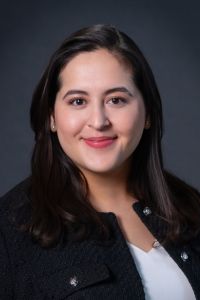Women in Medicine: Standing on the Shoulders of Giants
Published September 23, 2025
Inside OME
 by Kaitlynn McClellan, OMS II, University of the Incarnate Word School of Osteopathic Medicine
by Kaitlynn McClellan, OMS II, University of the Incarnate Word School of Osteopathic Medicine
There was a time when the idea of women in medicine was nearly unthinkable. Now, every September, we pause to celebrate women physicians who have broken barriers and transformed patient care. As a second-year medical student just beginning to find my footing, I wanted to take stock of what it means to be a woman in medicine before I step into my clinical years. To better understand this journey, I turned to two physicians I deeply admire: Carol Browne, DO, current chair of Osteopathic Principles and Practice at University of the Incarnate Word School of Osteopathic Medicine (UIWSOM) and director on the American Osteopathic Board of Family Physicians, who has more than 39 years in practice; and Denise Vera Nemeth, DO, who was named Student Doctor of the Year by AACOM, Texas Osteopathic Medical Association, American College of Osteopathic Surgeons and UIWSOM in 2025. She is now in her intern year in general surgery. Their insights, woven with my reflections, paint a picture of both progress and persistence of how far women in medicine have come, and the invisible costs that remain.
As a student, I'm struck by statistics showing that patients often have better outcomes with female physicians. Many patients report that women doctors show greater empathy and invest deeply in their well-being. Dr. Browne's perspective confirms how this shows up across a career: "Women seek out women physicians ... women in general spend more time with their patients and seem to listen more.' I think my patients perceive me as down-to-earth, practical and genuinely caring about them and their health." I think the idea that all women are inherently more nurturing can be misleading. Instead, women in medicine have had to navigate a social and hospital system where they are more conscious of their words and actions. That heightened awareness breeds the skills that allow us to think through clinical situations with care and precision. Dr. Nemeth put it plainly: "I have had to think twice, often daily, about how assertive I can be without being labeled 'difficult,' while my male colleagues are praised as confident leaders for the same behavior. That constant self-monitoring is not a small thing. It is an invisible tax women in medicine pay every day." That "invisible tax" shapes habits that patients interpret as listening, attentiveness or compassion. In truth, it's the lived experience of being a woman, balancing perception and professionalism, that gives us the tools that translate into stronger patient relationships.
One of the most inspiring aspects of talking with both women was hearing how their presence has changed culture. Dr. Nemeth described a moment of recognition: "I've had students and younger colleagues, especially women, tell me that seeing me in this role helped them picture themselves here too. I understood that I wasn't just caring for patients—I was also quietly shaping the culture by making space for others to imagine a future in medicine." Representation is powerful. As a student, I often look for role models who prove that balancing authenticity and excellence is possible. Seeing women physicians at every stage, from mentors nearing four decades in practice to those just beginning surgical residency, shows me that my path is supported. Dr. Browne echoed this: "Be proud of yourself and know your worth. Always do your best and don't apologize for wanting to have a life outside of medicine. Patients will appreciate you and your compassionate approach to their care."
As I prepare to enter rotations, I asked both physicians what advice they would give their younger selves. Their answers echoed a theme: sustainability. Dr. Browne encouraged early networking and engagement with osteopathic organizations, while stressing balance: "Medicine is my career, not my life," she said, reflecting on sacrifices she made while raising her children alongside her practice. Dr. Nemeth offered guidance I find especially relevant: "Don't lose yourself trying to fit the mold. A meaningful career isn't just about survival—it's about alignment. Keep your hobbies, nurture your friendships, learn new things. It's okay to want more. To build a career that feeds you, not just one that impresses others." Her reminder feels almost radical in a culture that prizes endurance and self-sacrifice.
I'm grateful for the women who came before me, women who endured hardships, worked until they went into labor and shouldered burdens their male colleagues never had to think about. Being a woman in medicine today means standing on the shoulders of giants. As Dr. Nemeth put it, "It means carrying both the privilege of deeper patient connections and the burden of expectations that sometimes feel impossible to meet." But above all, it means belonging to a community of physicians who, by their presence, have changed what medicine looks like for the better and still envision what it can become. As I step into my clinical years, I'll carry Dr. Browne's words of wisdom to "be proud of yourself and know your worth". Her words feel more like a roadmap, making me hopeful that the next generation of women in medicine and I will practice in a world where our worth is not questioned, leadership is not doubted and happiness is not a trade-off, but a priority.
